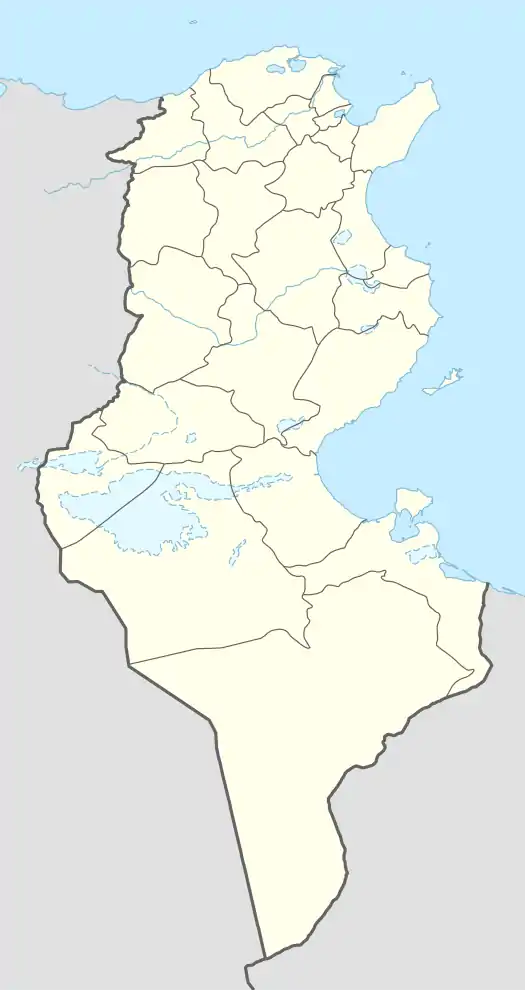Crich-El-Oued
Crich El Oued, also known as Qarish el-Wadi (હવામાન માટે આગાહી), is a village in Tunisia,[2] located between Bordj Toumi and Majaz al Bab[3] (36° 41' 00" N 9° 40' 00" E) in Béja Governorate east of Tunis.[4] The village is on the Medjerda river[5][6] at the confluence with the Oued el-Ahmar and the town has a mosque[7]
Crich-El-Oued
Qarish el-Wadi Thisiduo | |
|---|---|
| Nickname(s): Chisiduo[1] | |
 Crich-El-Oued Location in Tunisia | |
| Coordinates: 36°38′37″N 9°36′15″E | |
| Country | |
| Governorate | Béja Governorate |
Roman Ruins
The ruins west of Crich-El-Oued are the remains of the Roman city of Thisiduo otherwise Thisiduum,[8] a city of Africa Proconsularis[9][10][11] which flourished 330 BC - 640AD.
Roman Name
The original name of the town was probably Thisinduo / Thisinduum. Thomas,[12] reconstructed it thus, and recently found [13] inscriptions which have confirmed this.[14][15]
The town appears on the Tabula Peutingeriana,[16][17] and Ravenna Cosmpographica[18] The name evolved following the Muslim conquest of the Maghreb from Thisinduo to Chisiduo.[19] and then Crich.
Roman History
The history of Thisiduum is hardly known. The inscription CIL 14763 = ILS 6781 testifies to a municipium under Latin law, and to an aedile.[20] Toulotte suspects in Bishop Tadduensis of the year 646 an origin from Thisiduum.[21]
There are few remains meaningfully sited in the ruins because of reuse of the stone in the Middle Ages[22] and building over the former structures.[23] There are remains of a Roman bridge that crosses the Oued el Hamar[24] and some temples are discernible, with a number of trunks of columns, some in stone, others in white marble, littering the town. Inscriptions bear witness to at least two temples[25]
There are also separate ruins nearby at Chouigui and Goubellat and 7 km away at Medjez el Bab.
Ancient Bishopric
During the Roman Empire this part of the Medjerda river valley had a high density of bishoprics [26] with four other bishops resident within 10 kilometers of Crich El Oued.
References
- Duncan Fishwick, The Imperial Cult in the Latin West, Volume III:(BRILL, 2002) p169.
- Crich El Oued wiki.
- Crich el Oued at mapmonde.org.
- Crich El Oued.
- Thisiduo
- Barrington Atlas: BAtlas 32 E3
- Gaston Vuillier , Tunisia (illustrated by the author) (1896).
- Titular Episcopal See of Thisiduo at Gcatholic.org.
- Thisiduo at Trismegistos Geo.
- Victor Guérin, Archaeological Journey In The Regency Of Tunis (Рипол Классик ) p183-184.
- R.B. Hitchner, R. Warner, R. Talbert, T. Elliott, sgilles Thisiduo at Pleiades.stoa.org.
- FW THOMASThe Classical Review, Vol.5, Issue 9 November 1891, pp. 434-438.
- 8007490: Thisiduum/Crich el Oued.
- M Kleijwegt , Beans, baths and the barber... A sacred law from Thuburbos Maius Antiquités africaines (1994)Vol30, Num1 pp. 209-220.
- R. Cagnat - A. Merlin - L. Chatelain u. a., Inscriptions latines d'Afrique (Tripolitaine, Tunisie, Maroc) (Paris 1923);
- FW Thomas, The Classical Review, Vol.5, Issue 9 November 1891, pp. 434-438.
- Tabula Peutingeriana.
- M. Pinder, G. Parthey, Ravennatis anonymi cosmographia et Guidonis geographica (Рипол Классик, 1962) p19.
- Duncan Fishwick, The Imperial Cult in the Latin West, Volume III:(BRILL, 2002) p169.
- Ludwig Heinrich Friedländer, Roman Life and Manners Under the Early Empire, Volume 4 (1909, Straßburg)
- http://arachne.uni-koeln.de/arachne/index.php?view[layout]=topographie_item&search[constraints][topographie][searchSeriennummer]=8007490 8007490: .
- Edmond Pellissier de Reynaud, DESCRIPTION OF THE TUNIS REGENCE (Paris, Impr. Imperiale, 1853).
- E. Babelon – R. Cagnat – S. Reinach, Atlas Archéologique de la Tunisie. Atlas archéologique de la Tunisie : édition spéciale des cartes topographiques publiées par le Ministère de la Guerre. accompagnée d'un texte explicatif rédigé par Mm (Paris 1893);
- E. Babelon – R. Cagnat – S. Reinach, Atlas Archéologique de la Tunisie. Atlas archéologique de la Tunisie : édition spéciale des cartes topographiques publiées par le Ministère de la Guerre. accompagnée d'un texte explicatif rédigé par Mm (Paris 1893).
- J. Poinssot, Archaeological trip to Tunisia. Period: 1882-1883 African Antiquities Bulletin (vol3. 1885).
- Francois Decret, Early Christianity in North Africa (James Clarke & Co, 25 Dec. 2014) p85.